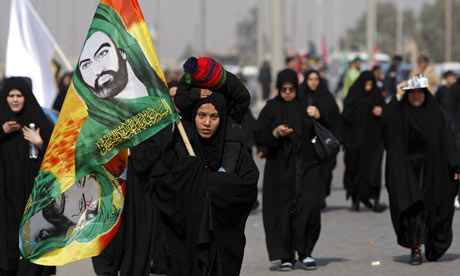Suicide bomber kills 27 Shias Near Baghdad
Shia pilgrims leave Baghdad on their way to the holy city of Kerbala to mark a Shia holy day
NEW DELHI: A suicide bomber killed 27 Shi’ite militiamen on the outskirts of the Iraqi town of Jurf al-Sakhar, which in turn, was in the news this week as security forces pushed Islamic State militants out to regain the town over the weekend.
The attacker was driving a vehicle loaded with explosives, injuring 60 Shi’ite militiamen -- who helped Iraqi forces regain the town -- in addition to killing 27.
The attack comes ahead of the celebrations of the Shia festival of Ashura, and demonstrates the sectarian faultlines that have come to characterize Iraq -- which is battling extremist militias, most prominent among which is the Islamic State.
As the Islamic State continues its advancement toward Baghdad, gaining territory in Anbar province, violence -- targeting Shias and Sunnis -- has continued unabated.
In August, a suicide bomber hit a Shiite mosque, killing at least 12 people and injuring 26 others in Baghdad. On the same day, in Kirkuk, three car bombs detonated killing 21 people and injuring another 130. The bombings had followed an attack on a Sunni mosque Iraq’s northeastern province of Diyala that killed 73 people, leading many to believe they were reprisal attacks.
In fact, reprisal attacks are an under reported aspect of violence in Iraq, with Amnesty International recently releasing a report that documented this reality. It concluded that in “ recent months, Shi’a militias have been abducting and killing Sunni civilian men in Baghdad and around the country. These militias, often armed and backed by the government of Iraq, continue to operate with varying degrees of cooperation from government forces –ranging from tacit consent to coordinated, or even joint, operations.”
The report went on to say that it holds the Iraqi government “responsible for the serious human rights abuses, including war crimes, committed by these militias.” The report detailed the plight of victims, found dead or still missing, using accounts by family members and witnesses. These accounts are corroborated by Ministry of Health workers, who told Amnesty International that in recent months they have received scores of bodies of unidentified men with gunshot wounds to the head and often with their hands bound together with metal or plastic handcuffs, rope or cloth.
Such crimes are being perpetrated against a background of increased sectarian tensions in the country. Since Iraqi central government forces lost control of much of northern Iraq to “the Islamic State” (IS) last June, sectarian attacks have spiraled to a level not seen since 2006-2007, the worst period of civil strife in the country’s recent history. Government-backed Shi’a militias and Sunni armed opposition groups have both been targeting civilians from each other’s communities.
It is these sectarian divisions that can explain the rise of the Islamic State in the first place. Ironically, although the US-led western coalition blamed the Iraqi government, led at the time by Nouri al-Maliki, for exacerbating sectarian tensions, the seeds were sown following the 2003 US invasion of Iraq. When the US invasion toppled Saddam Hussein, a need emerged to replace the security vacuum with a new political elite. The main opposition to Hussein at the time were ethno-sectarian parties, and the US brought these factions to power cementing identity politics in the region.
This creation of identity-based politics, paved the way for sectarian identity to become a key political factor. Prior to 2003, although a limited notion of a Shia identity and a Kurdish identity did exist in Iraq, there was no concept of a homogenous Sunni identity. The divisive policies of the Iraqi state -- facilitated by the US -- have paved the way for the emergence of a Sunni identity.
It is this emergence of a Sunni identity rooted in the notion of victimhood, that made the emergence of IS in Iraq possible, and that has led to an increase in sectarian violence across the region.





